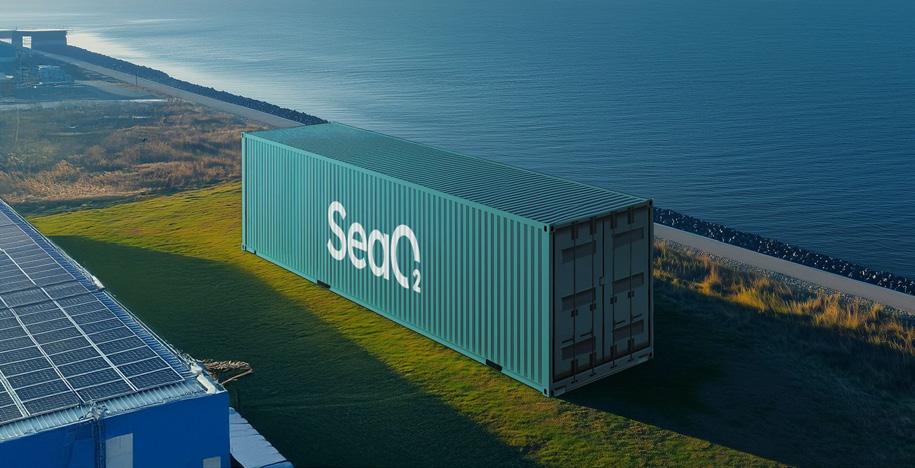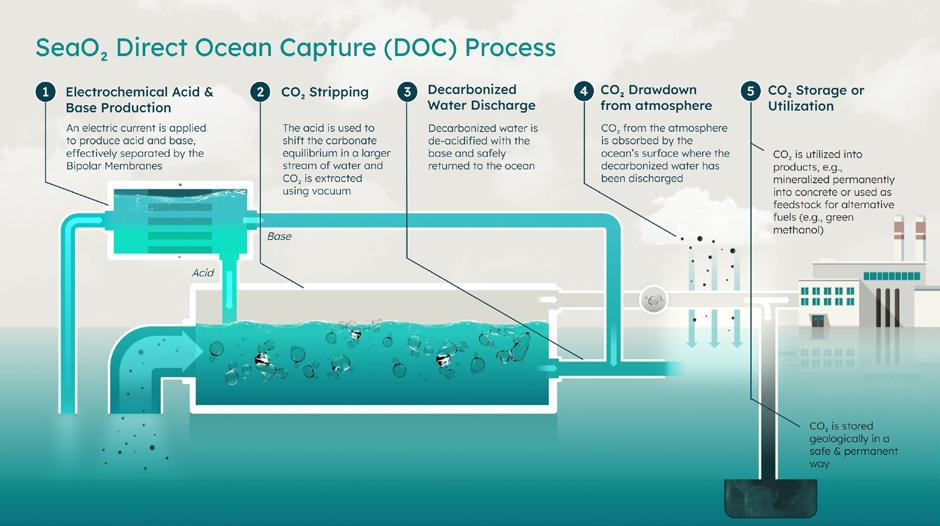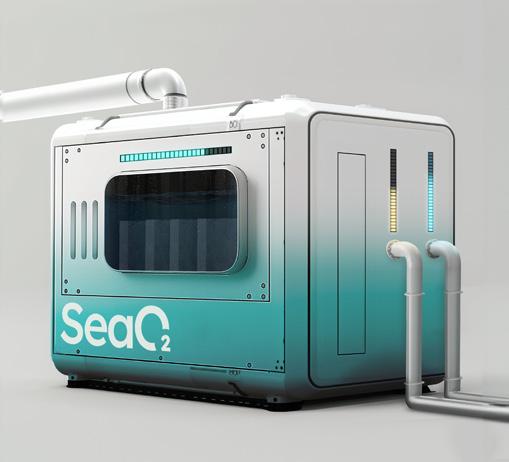
7 minute read
Yesterday's fossil fuel infrastructure - tomorrow's climate solutions. Ocean-based carbon removal
by Alexa Ivy
The Dutch climate tech start-up SeaO2 has announced a bold vision to turn the ocean into a climate solution, harnessing innovative technology to remove carbon dioxide at a gigatonne scale. The company has recently secured over €2.0 million in funding to accelerate the development of its Direct Ocean Capture (DOC) technology. Their approach targets extracting CO2 directly from seawater, hence addressing the dual challenge of climate change and ocean acidification. The recent investment will enable SeaO2 to transition from prototype development to a fully operational pilot plant, set to launch by mid-2025 and scale its tech towards the ambitious goal of removing one gigatonne of CO2 annually by 2045.
At the core of SeaO2’s approach lies its innovative technology. Unlike land-based carbon capture solutions that face limitations in scalability and cost, DOC leverages the vastness of the oceans. As the world’s largest natural carbon sink, oceans absorb around 25% of global CO2 emissions per year. However, this process has contributed to rising ocean acidification, threatening marine ecosystems and biodiversity. The company’s technology directly tackles these challenges by extracting CO2 from seawater and returning carbon-free water to the ocean. This process effectively resets the equilibrium, enabling the ocean to absorb more atmospheric CO2 while mitigating acidification. “Our goal is to create a sustainable, scalable solution that delivers measurable climate benefits while protecting the oceans,” underscores Ruben Brands, CEO and Co-founder of SeaO2 . The captured CO2 can be permanently sequestered in geological formations or utilised in industrial processes, supporting the transition to a growing circular carbon economy.

A multifaceted platform for combating climate change
SeaO2’s long-term vision involves establishing offshore DOC hubs, a transformative concept designed to repurpose decommissioned oil & gas platforms. This is a significant opportunity, given S&P Global’s forecast that worldwide offshore decommissioning expenditures could reach nearly $100 billion between 2021 and 2030. These hubs will serve as integrated sites for carbon removal, powered by renewable energy from offshore wind farms, something that will not only support the relatively energy-intensive DOC process but also assist with grid balancing. “We see an incredible opportunity to turn yesterday’s fossil fuel infrastructure into tomorrow’s climate solutions,” says Brands.
SeaO2 envisions creating offshore hubs co-located with geological CO2 storage facilities, enabling the permanent sequestration of captured carbon. These hubs will serve as scalable solutions for DOC, addressing the gigatonne-scale carbon removal challenge. To speed up global deployment, SeaO2 plans to implement a licensing model that empowers partners globally to establish their own hubs, creating a robust, interconnected network of carbon removal and storage facilities.
These hubs will additionally unlock broader decarbonisation opportunities by supporting hydrogen production through third-party collaborations. The captured CO2 and produced hydrogen can be combined to generate green methanol, providing offshore access to net-neutral fuels. This vision aligns with efforts to decarbonise hard-to-abate sectors, such as maritime transportation, enabling ships to bunker sustainable fuels directly at these offshore hubs.
By integrating carbon removal, storage, and renewable fuel production, SeaO2 aims to transform offshore infrastructure into a multifaceted platform for combating climate change and advancing the energy transition.
From lab- to giga-scale
The €2.0+ million funding round – led by investors such as DOEN Participaties, NOM NEW-TTT fund, Future Tech Ventures, CarbonFix, and Transavia Ventures – marks a significant milestone in SeaO2’s journey. This investment will enable the company to build its first pilot plant with an annual capacity of 250 tonnes of CO2 removal. The facility, scheduled for launch in the summer of 2025, represents a key step towards demonstrating the commercial viability of SeaO2’s technology.
“This funding is a recognition of the hard work and dedication of our team,” underlines Brands. “It allows us to transition from lab-scale prototypes to real-world implementation, bringing us closer to our goal of removing one megatonne of CO2 by 2030 and scaling to a gigatonne by 2045.” To this DOEN Participaties added, “We are investing in SeaO2 because current carbon removal methods are not yet effective at the required scale. Therefore, innovations like SeaO2 are urgently needed, and funding is essential to drive the sector forward and unlock its potential for global impact.” CarbonFix, another key supporter, highlighted, “CarbonFix is proud to have helped build this coalition. Our role in the ecosystem is to catalyse networks, funding, and talent to unlock innovative pathways in the fight against climate change. SeaO2 is a prime example of this impact.”
Apart from building the pilot plant, SeaO2 will use the funding to enhance its team and develop a robust monitoring, reporting, and verification system. This ensures that the company’s carbon removal efforts are transparent, verifiable, and aligned with industry standards.
In the meantime, SeaO2 has established strategic partnerships with leading organisations, including XPRIZE Carbon Removal, the Delft University of Technology, Wetsus, and Redstack. These collaborations have been instrumental in advancing the company’s technological innovation and market reach. Notably, SeaO2 participated in a successful carbon removal project with Paebbl in the Wadden Sea as well as achieved recognition among the top 100 teams in the prestigious XPRIZE competition. The company also delivered award-winning pitches at high-profile events, including The Next Web, Tech Tour Oceans, and Tech Tour Water. “Our journey has been accelerated by these partnerships and the insights we’ve gained through programmes like XPRIZE, PortXL, and Ocean Vision,” Brands shares. “Each step brings us closer to scaling our impact globally.”

Pump and process
While the long-term vision focuses on offshore hubs, SeaO2 is taking immediate steps to integrate its technology with industries that already use seawater in their operations. These include thermal power plants that utilise water for cooling, desalination plants, wastewater treatment facilities, and aquaculture operations.
By collaborating with these sectors, SeaO2 can leverage existing infrastructure to reduce costs and step up deployment. This tactical approach allows the company to demonstrate the feasibility of its technology and establish early success stories, building momentum for larger-scale adoption. “Working with industries that already pump and process seawater is a pragmatic way to achieve short-term impact while paving the way for our larger vision,” Brands explains.

A powerful ally
SeaO 2 aims to remove one gigatonne of CO 2 annually by 2045, a target that aligns with global efforts to achieve net-zero emissions. By combining innovative technology with strategic partnerships, visionary funding, and a clear roadmap, the company is well-positioned to meet this ambitious target. “Our vision is to transform the ocean into a powerful ally in the fight against climate change,” Brands shares. “With the right support and collaboration, we can scale our impact to the level required to make a real difference.”
By integrating its technology into existing industries and establishing offshore hubs powered by renewable energy, SeaO2 is creating a scalable and sustainable framework for global carbon removal. As the company moves towards large-scale implementation, it stands as a beacon of hope in the battle against climate change.
The mission of SeaO2 is to protect our planet from getting warmer and warmer – by reducing the CO2 concentration in the ocean and indirectly in the air. To keep us all cool. To de-acidify our oceans so pH is restored. To benefit biodiversity. Founded in 2021 and born from tech developed in the Delft University of Technology and Wetsus’ laboratories, SeaO2 provides cost-efficient atmospheric carbon removal by leveraging our biggest ally in battling climate change – the ocean. Check seao2.com to learn more.








